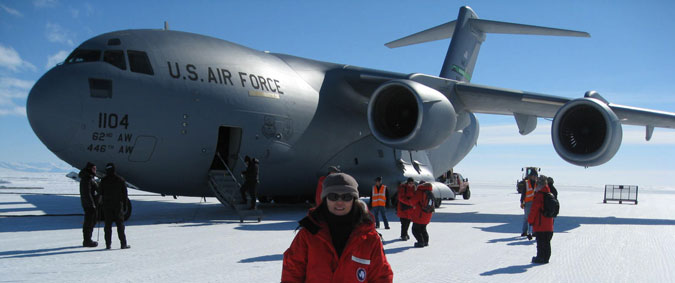For 100 years, cosmic rays have been a mystery of galactic proportions. Now CMNS scientists are helping to find a solution.
Cosmic rays—high-energy, electrically charged particles which range from lightweight electrons to the massive nuclei of heavy atoms—strike the Earth from all directions, colliding with air molecules and generating "showers" of subatomic bits and pieces that rain down on us every minute of every day. Detector arrays on the planet's surface record the arrival of this collision debris (and the radiation it generates) and extrapolate backwards to calculate the energy of the incoming particle.
Most of these celestial bullets clearly originate from the sun and other familiar objects in nearby space. But when a few have energy levels so outrageously high that their sources are still unknown, and research teams around the world are at work on the problem. One of the foremost is the Cosmic Physics Group led by University of Maryland Associate Professor Eun-Suk Seo.
"From the ground measurements," Seo says, "you know the cosmic rays have extraordinary energies. But you don't know what kind of particles they were to start with, because they are broken up already by the time the shower is detected. Our approach is to measure these particles directly before they interact with the atmosphere."
She and colleagues in UMD's Physics Department and Institute for Physical Science and Technology have designed, fabricated and deployed a unique suite of balloon-borne instruments capable of identifying the specific elements and energies of some of the fastest-moving cosmic rays. These devices operate at an altitude of 40 km, above 99% of the atmosphere, riding the stratospheric polar vortex that circles the South Pole and thus conveniently returns the balloons to the point at which they were launched. In the past decade, the instruments have not only expanded our understanding of high-energy cosmic phenomena, but have produced unexpected discoveries of major significance.
For example, an instrument created by Seo and collaborators recently made headlines by detecting what may be evidence of "dark matter" particles—the invisible, ghostly stuff that is known to make up at least four-fifths of the matter in the universe, but which has never been observed directly.
To learn more about Seo's science team and the quest to understand cosmic rays, click on the four topic areas listed in the above.
For detailed technical information, see the web sites at http://cosmicray.umd.edu, http://www.atic.umd.edu/atic.html, and http://cosmicray.umd.edu/cream/cream.html.
For information on ground-based detection, see http://umdgrb.umd.edu/cosmic/milagro.html and http://www.lanl.gov/milagro, as well as a recent news release http://www.newsdesk.umd.edu/scitech/release.cfm?ArticleID=1796

Eun-Suk Seo
Associate Professor |
Dr. Seo received her PhD in 1991 from Louisiana State University after studies that included more than two years as a Visiting Graduate Student at NASA's Goddard Space Flight Center. After obtaining her degree, she came to the University of Maryland as a Research Associate and has remained at UMD ever since. She is now an Associate Professor, holding joint appointments in the university's Department of Physics and the Institute for Physical Science and Technology. She has written or coauthored dozens of papers in refereed journals.
Seo has worked on numerous projects for the detection and characterization of cosmic rays, including four major international collaborations: ATIC (the Advanced Thin Ionization Calorimeter), AMS (the Alpha Magnetic Spectrometer, intended for deployment on the International Space Station), BESS (the Balloon-borne Experiment with a Superconducting magnet Spectrometer) and CREAM (the Cosmic Ray Energetics and Mass program).
During December of 2008, she traveled to Antarctica for the launch of CREAM Flight IV from McMurdo Station, the U.S. Antarctic Program's main base.
Seo's work is supported by NASA. The United States Antarctic Progam is funded and managed by the National Science Foundation.
"Astronomers use photons in various wavelengths to study the universe. Complementary to that, we are using charged particles—a direct sample of matter from outer space. In this vast universe, you can't really rely on only one sense or one source of data. It would be like a blind man trying to understand an elephant by touching only a foot. Each kind of research provides one part of the puzzle." |

Back to Top
|

